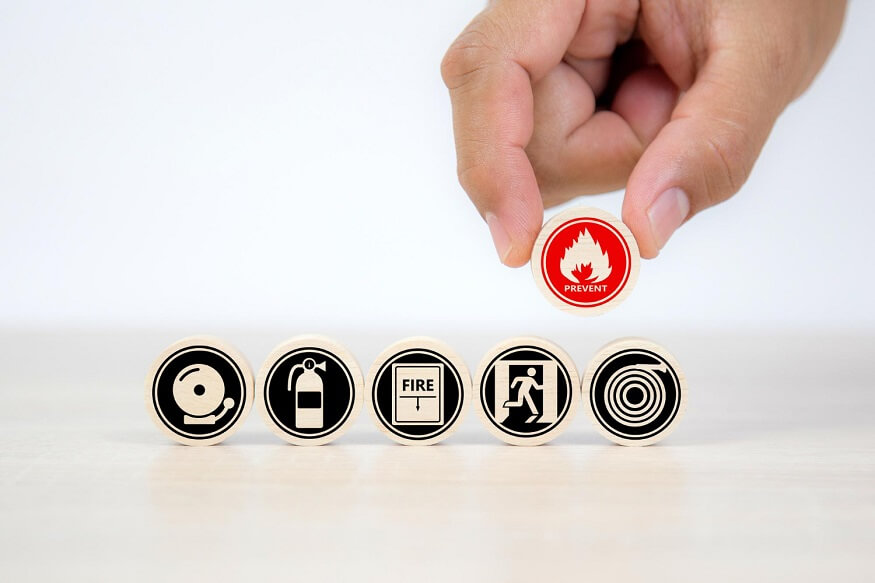Perhaps a fire started because someone left a candle too close to an inflammable object, or a fire started in the kitchen and got out of hand. Fire hazards are all around us and we can never know what triggers an incident. The important question to ask, however, is in the event of a fire, do you or your children know what to do?
Fire safety is a critical life skill that should be taught to children from an early age. Fire can be dangerous and terrifying for kids as well as adults. However, with the right knowledge and skills, we can empower kids to understand the dangers associated with fires and how to prevent them.
Also Read: How a five-point safety harness keeps your child safe
Fire Safety Tips for Children
In this blog, we will present valuable fire safety tips for kids that can help protect them and their loved ones from potential harm.
- Teach the importance of smoke alarms
- Devise a family evacuation plan
- Stay Low and Crawl
- Stop, Drop and Roll
- Learn the use of fire extinguishers
- Identify potential fire hazards
Just like in workplaces, it is crucial to have a smoke alarm installed in every home or apartment complex. Teach children about the purpose and significance of a smoke alarm. Show them how these devices work to detect smoke and warn residents in case of a fire emergency. In severe fire incidents, smoke inhalation can be more dangerous than the flames themselves.
Train children to alert and inform an adult as soon as they hear the smoke alarm sound.
One of the most important fire safety measures for children is keeping them informed about an evacuation plan. Sit them down and discuss different escape routes from each room at home in case of an incident. The evacuation plan must include a designated meeting point outside the house for all members to assemble.
Teach them how to unlock windows, and doors properly for a safe escape. Make them aware of the fact that they should never go back inside a burning building under any circumstances.
Practise the plan regularly with your kids until they learn to remain calm and feel a sense of preparedness and confidence to handle a fire situation.
Emphasise the importance of staying low and crawling during a fire to avoid inhaling the smoke in excess. The air closer to the ground is bound to be cooler and less smoky. Teach children to crawl on their hands and knees to increase their chances of a safe exit.
Teach children the “Stop, Drop and Roll” technique that can be a life-saving one in the event their clothes catch fire. Teach them that if their clothes are on fire, they should immediately stop. Drop to the ground, cover their face with their hands and roll back and forth to put off the fire.
Knowing this technique will reduce the risk of severe burns.
A fire extinguisher is an important fire safety equipment. Children should never attempt to extinguish a large fire. However, teach them to use a fire extinguisher to be used by them only when the fire is small and manageable. Show them the PASS technique- pull the pin, aim at the base of the fire, squeeze the handle, and sweep the extinguisher from side to side. It is, however, advised for kids to evacuate first and call for help.
Also Read: 10 Safety Rules at School You Must Teach Your Children
Help children identify potential fire hazards within their surroundings. Fire hazards could be:
-Matches
-Lighters
-Candles
-Stoves
-Electrical outlets
-Portable heaters
-Fireworks and outdoor fires
-Flammable materials
Here are some basic rules for handling the above hazards:
- Do not play with matches and lighters.
- Do not leave candles unattended. Extinguish candles before leaving the home.
- Stay away from playing near stoves and fireplaces especially when someone is cooking.
- Do not overload the electrical socket by plugging in too many devices.
- Turn off the heaters before leaving the room
- Keep flammable materials like gloves, towels, cleaning agents, aerosol sprays, and flammable liquids away from any fire source.
- Teach kids to handle age-appropriate firecrackers and light them only under adult supervision.
- Outdoor fires like a bonfire are not to be touched and should be lit away from any flammable materials.
- Avoid leaving cooking appliances unattended. Pans, ovens, and stovetops can become hot and cause fires.
- Do not hide
- Take the stairs
- Cool down minor burns
- Know the emergency number
- Ensure fire safety outside of the home
Children tend to run and hide in nooks and corners when terrified. In the event of a fire, it is important to escape and never hide. Hiding in cupboards, behind doors, or under the beds is never advisable as it will make it difficult for the rescue team to find you or even reach you.
Never take an elevator in a burning building. Always use the stairs to get to your designated meeting point in case of a fire. Elevators might stop working due to the fire and you would be stuck inside. Prioritise getting yourself out first and leave everything else behind when escaping.
In case of a minor burn, run cool water over the burn. In case of blisters, show them to a qualified medical practitioner.
Teach children to call the emergency services. Ensure they know the home address and can recall it correctly to the operator. Practice making emergency calls and emphasise the need to remain calm to seek the right help.
While children must understand fire safety norms at home, they should also recognize that fires can start elsewhere. Teach them about fire safety when visiting public places, such as schools, libraries, or shopping centres. Encourage them to locate emergency exits and understand evacuation plans in case of fire emergencies.
Awareness about fire safety outside of the home will help children will be better prepared in any situation.
Also Read: Causes of Lightning and Precautions to Take
Conclusion
Educating children on fire safety is crucial to ensure their well-being. By making them aware of the hazards around them and by taking proactive steps to prevent any accidents, we can create a safer environment for our little ones.










